Hello lovelies!
As you all know, Ancient Egyptians invented the concept of cosmetics as we know it. But Ancient Romans took it to another level.
Indeed, since the creation of the Roman Empire, Ancient Romans constantly got inspiration from conquered people for their beauty rituals. And these ancient beauty secrets included many rituals that were used for many centuries. However, some of these Ancient Rome’s beauty secrets were quite gross…Without further ado, let’s discover these ancient beauty secrets!
Disclaimer: This post contains affiliate links to help me support this blog. I may earn a commission whenever you click on the links and purchase the products, with no additional cost to you. Thanks in advance for your support!
Venus or the eternal femininity
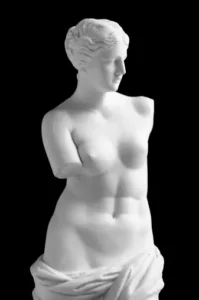
Who symbolizes beauty more than Venus? Yet, Venus started as a minor deity worshipped in a small village near Rome. However, when Roman people assimilated Venus to Aphrodite, the Greek goddess of beauty and fertility, things changed. Venus embodied the ultimate femininity. And Ancient Romans initiated a limitless worship to her.
Even Julius Caesar built a giant statue of Venus because he claimed that his lineage came from her. Soon, many temples and statues were built in her honor. But what does explain this success of Venus?
Actually, Venus had all the beauty attributes that delighted Ancient Romans at that period. They include an attractive face, a sumptuous head of blond hair, sensual eyes, and an engaging smile. Moreover, she was a smooth talker and knew how to play with eloquent silence to entice her lovers!
As the goddess of beauty and fertility, Venus had several plant attributes. For instance, rose, myrtle, apple, carnations, and poppies are all linked to Venus. Unsurprisingly, cosmetic companies still use these ingredients in their formulas today. Is it possible that the cosmetic industry is under the tutelage of Venus?
Ancient Rome’s Beauty Secrets: Skincare for a white and flawless skin

In Ancient Rome, the ideal skin was pale, flawless, and smooth. And having the ideal skin type was extremely important for women as well. Indeed, they needed to have a healthy and chaste appearance to increase their marriage prospects. Therefore, caring for their skin was extremely important for Ancient Romans.
In this perspective, Ancient Romans relied heavily on creams, lotions, and face masks to get the complexion of their dreams. Those products would help them fight wrinkles, pimples, sunburns, freckles, and flaking.
They would use many mixtures including the following ingredients:
- lentils
- barley
- lupine
- honey
- fennel
- oils
- oregano seeds
- sulphur
- vinegar
- goose grease
- basil juice
- hawthorne
Sometimes, they would add essence of rose and myrrh to their mixtures.
However, some ancient beauty secrets of Ancient Romans included unusual or disgusting ingredients. For instance, some recipes included placenta, animal urine, and/or excrements of calves or kingfishers. If you thought that Korean and Japanese had weird beauty rituals, think twice!
Moreover, there were specific mixtures for specific problems. For instance, Ancient Romans cured pimples with a mixture of barley flour and butter. And for sun spots, they would use ashes of snails. Cheers!
Also, plebeian Roman women made their beauty recipes themselves. However, rich women had specific slaves called cosmatae. Those servants were highly sought after and dedicated themselves to adorn and beautify their mistress. They would make exclusive secret recipes that would be used only by their mistress.
Ancient Rome’s Beauty Secrets: Good hygiene was a must
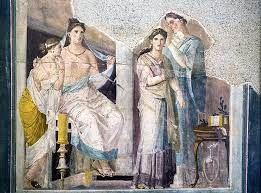
For Ancient Romans, cleanliness was next to godliness. And they took great care of their hygiene, whether they were rich or poor. To wash, Ancient Romans used a mixture of ashes, soda, and oil. They would put it on their skin, rinse and do a “peeling” with a strigil.
Later, they would wash with the ancestor of soap. This foaming paste was an ancient beauty secret from Gallic people. It was made of goat grease and ashes from beech soapwort. The Romans perfected this recipe as time went by.
Also, Roman women enjoyed baths of all sorts. For instance, rich women would indulge in donkey’s milk baths popularized by Cleopatra. Empress Poppaea, Nero’s wife, had a herd of donkeys that were ready to provide the milk she needed for her bath.
Moreover, Ancient Romans enjoyed steam baths and went regularly in places called balnae. Real thermal baths in the Latin tradition only saw the light a few years before Christian era, under Agrippa’s consulate. These premises were accessible to all, regardless of social class, and open to both men and women.
Those thermal baths were dedicated not only to personal hygiene and body care, but also to health and relaxation. In particular, women used to get massaged with scented oils. The rumor has it that they really favored sisymbrium oil, as it gave them a smooth skin.
Rich people had private thermal baths in their homes, with slaves who took care of them out of sight.
Ancient Rome’s Beauty secrets: Winner’s smile

Did you think that white teeth was only a recent beauty requirement? Then, you’re wrong! Ancient Romans found a good set of strong and white teeth very attractive. This was so important that only people with good teeth were encouraged to smile!
However, to keep their teeth white, Ancient Romans had a beauty secret. Indeed, they made a toothpaste with the ashes of animal bones or teeth. And if they lost their teeth, they would use ivory or bone prostheses attached with a gold wire.
Ancient Rome’s Beauty Secrets: Makeup in the Ancient Rome style
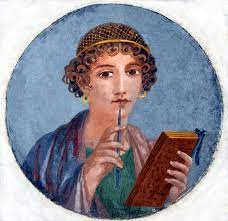
After having achieved a smooth skin with skincare treatments, Ancient Roman women relied on makeup to enhance their features. However, makeup for men was not socially acceptable. Indeed, Romans found it immoral and effeminate. But some men used white powder on their face to lighten their complexion.
Enhancing their complexion
As we saw earlier, Roman women favored a pale complexion. This gave the impression of a leisurely lifestyle where there is no need to work hard under the sun. However, many Roman women were naturally born with a darker complexion.
Consequently, they would use white powders containing chalk or lead. The latter was extremely toxic and poisonous; and could lead to several ailments including death.
Moreover, they would use blush to enhance their cheekbones. They made blush with red ochre, wine dregs, or mulberries. Some women would even draw blue veins on their temples to accentuate their paleness.
Sultry eyes
Like Ancient Greeks, Ancient Romans liked large eyes with long eyelashes and a unibrow. To achieve their desired look, they would have blue and green eyeshadows made from various minerals (malachite for green and azurite for blue).
Moreover, they would take after Cleopatra’s visit in Rome to adopt her smoky eyes. But they would use their own version of kohl made with soot, saffron, ashes, or antimony. Moreover, they would also use date stones and charred rose petals to darken their eyes.
When they wanted to create a unibrow they didn’t have naturally, Ancient Romans had their secret hacks. Indeed, they would draw it or glue animal hair on their face.
Red lips
Ancient Roman women favored red lips. To achieve this look, they relied on a mixture made with bromine, beetle juice, beeswax, and henna.
Ancient Rome’s Beauty Secrets: Having hair like Venus
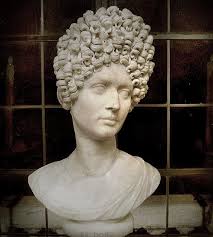
The desired hair in Ancient Rome were blond or auburn. But most Roman women had black hair. Therefore, they had to dye their hair to achieve their desired hair color.
For blond hair, they would use a mixture of goat fat and beech ash. They obtained auburn hair with a dye made with the juice of elderberries. For those who wanted to dye their hair in black or maintain their natural black hair, there was another solution. Indeed, they would use a mixture of black antimony, cypress leaves, vinegar or absinthe’s ashes, and rose oil.
Also, Roman women favored many hairstyles over the periods, but curls were a must. Thus, they used a curling iron to style their hair, with olive poil as a serum.
As natural hairstyles were associated with Barbarians, Roman women sported complex and elaborated hairstyles. The more complex the hairstyle, the wealthier the woman. A special slave called ornatrix would take care of the hair of rich women.
However, the hair of Roman women couldn’t resist to these multiple hair treatments. Therefore, they often had damaged hair. Consequently, they mostly wore wigs to hide it.
Wigs were made with human hair imported from Northern Europe for blond hair and from India for black hair. As wigs were made with natural hair, they were quite expensive. That’s why only rich women could afford them.
Hair removal
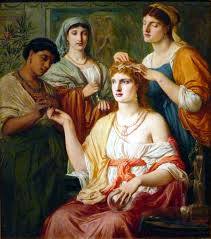
Though the unibrow was in, body hair in other body places was a no-no in Ancient Rome. In particular, smooth and hairless legs were a must. Therefore, they would pluck their hair by shaving, clipping, or with a plumice. Also, they would use hair removal ointments made with innards of various sea fish, frogs, and leeches.
Social norms in Ancient Rome also dictated that men would shave as well. However, men were not completely hairless, as Ancient Romans considered this as effeminate.
But they still had to find a balance because they had to be manly without appearing unkempt. Indeed, being unkempt was a sign of laziness or mourning. For instance, Emperor Caligula grew his beard as a sign of mourning when one of his sisters died.
Plump figure
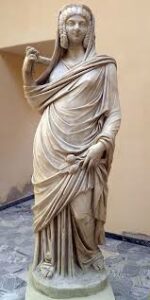
In Ancient Rome, the ideal woman was rather tall, plump, with wide hips and slanting shoulders. Thus, they would use many hacks to achieve the ideal proportions.
For instance, slender women hid their figure with thick clothing. Others would use shoulder pads to bulk up their upper body.Many mothers would even put their daughters on a diet to achieve the ideal figure. They weren’t allowed to ruin marriage prospects!
Perfume in ancient Rome
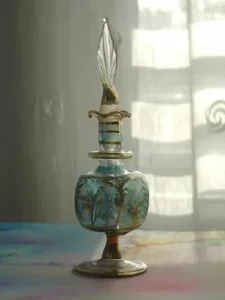
The many ingredients used in skincare treatments and makeup products had a foul smell. That’s why Ancient Roman women used perfume to hide all those smells.
As a pleasant smell represented good health, both men and women used perfume. However, men used less perfume than women, because they didn’t want to appear effeminate.
In Ancient Rome, perfumes were mixtures of flowers (iris or rose petals) and olive or grape juice. They would come in sticky, solid, or liquid forms.
Bonus: Beauty also starts in the plate

Like Ancient Egyptians and Greeks, Ancient Romans ate a Mediterranean diet. Indeed, their diet included cereals and legumes, with sides of fruits, vegetables, cheese, or meat. Moreover, they would eat sauces made with fermented fish, vinegar, honey, and various herbs and spices. Meat and fish were generally reserved for the elite.
Conclusion: what were the beauty secrets of Ancient Roman women?
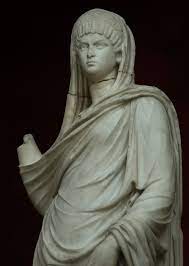
Ancient Rome’s beauty secrets included skincare treatments and makeup regimens relying on natural products. However, though many ingredients were natural and wholesome, some of them were also foul and smelly. Being a daughter of Venus wasn’t always completely restful. No pain, no gain!
Well, that’s all for today! What do you think of Ancient Rome’s beauty secrets? Do you use some of them in your beauty routine? Share your thoughts in the comments below!
Take care!
Want more content from me? Join my newsletter today and received the latest updates of my website. Also, you’ll receive a wonderful gift in your email!
Learn more:
Everyday Life in Ancient Rome by Lionel Casson

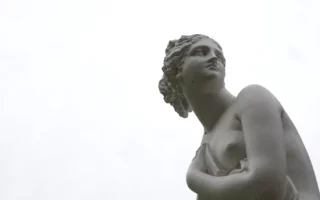


What a fascinating post on the beauty rituals of ancient Romans. I live in Rome, and was familiar with all the ancient Romans baths and thermal baths, but had no idea that women specifically would go to such lengths to achieve the ultimate look. Interesting that even in the ancient times, hairfree legs were desirable.
Although natural products were used to try and look like the beautiful Venus, some ingredients like placenta and animal urine and faeces were also included. You mention that lead was used to lighten the skin, but how did they use it? Was it in powder form that it was rubbed on the face? Or did they melt the lead and then put it on the skin? Thank you.
Hello LineCowley thanks for your comment! Lead was included in a powder or a kind of paste. This solution exists since the Greeks: https://beautybyelodie.com/8-s…
Wow, what an interesting article Elodie. It’s curious that even way back then, women were concerned about how they looked, keeping a certain aesthetic. Given that they were in the Middle East it must have been hard to not be tanned! As I was readying, I was thinking about how smelly it must have been when I got to your part on the perfume. I thought it was super interesting that they had slaves called: ‘cosmatae’ . Do you think this is where the word ‘cosmetic’ came from? Since you seem to be a history buff, do you know if the role of ‘cosmatae’ translated into other cultures after Rome fell?
Hello Debbie thanks for your comment! The term “cosmetics” comes from the Greek kosmetikon. Please read my article on Ancient Greek beauty secrets and about Queen Cleopatra: https://beautybyelodie.com/8-s…
https://beautybyelodie.com/que…
Thanks!
Wow, this is such a fascinating post and a great read! I visited Rome when I was a young child and got to see many of the ancient ruins. Studying classics at school has always given me a great interest in ancient Rome. I find it so interesting that then having pale skin was seen as the ideal skin type, showing how they were wealthy as they did not have to work outside. Compared to more recent times it is now the opposite, if you are tanned it could show wealth as you are not always indoors working.
Given that they used a whitening powder containing lead, was this not bad for their skin? Causing them to not have the complexion they desired?
Hello Ebony, thanks for your comment! Actually lead was extremely toxi and gave them a grey complexion in the end. So you’re sentenced to continue putting the powder on your skin to mask its imperfections and its actual color!
Hello There, what an interesting article. It’s curious that even way back then, women were concerned about how they looked, keeping a certain aesthetic. I know Ancient Rome had various beauty practices and secrets that were popular among its citizens.and so Here are some of the beauty secrets from ancient Rome. Romans enjoyed wearing perfumes and fragrances. They created their own scents using a mixture of oils, spices, flowers, and herbs. Perfumes were applied to the body, hair, and clothes to enhance personal fragrance. .and so Here are some of the beauty secrets from ancient Rome: Perfumes and Fragrances: Romans enjoyed wearing perfumes and fragrances spray, etc.
Bathing Rituals: Romans valued cleanliness and regularly indulged in bathing rituals. They would visit public bathhouses, where they would cleanse their bodies using oil, sweat, and a tool called a strigil to scrape away dirt and dead skin.
Skin Care: Romans used various natural ingredients for skincare. They applied mixtures of oils, such as olive oil or almond oil, to moisturize and protect their skin. They also used honey, milk, and egg whites in face masks to achieve a glowing complexion.
Perfumes and Fragrances: Romans enjoyed wearing perfumes and fragrances. They created their own scents using a mixture of oils, spices, flowers, and herbs. Perfumes were applied to the body, hair, and clothes to enhance personal fragrance.
Makeup: Both men and women in ancient Rome used makeup. They applied lead-based foundation called “cerussa” to lighten their skin tone. They also used rouge made from crushed berries or red ochre for a flushed cheek look. Kohl was used to darken the eyes, and lipstick made from crushed red pigments was applied to the lips.
Hair Care: Romans paid great attention to their hair. They used a variety of oils and pomades to condition and style their hair. They also used various accessories, such as hairpins, combs, and hairnets, to create elaborate hairstyles and keep their hair in place.
It’s important to note that while these beauty practices were popular in ancient Rome, some of them may not align with modern beauty standards or may even be harmful to health. It’s always advisable to exercise caution and consult with professionals before trying any ancient beauty secrets or practices.
Thanks for this long comment!
I definitely don’t think I would enjoy using some of these beauty treatments, especially if you know they are made of urine, placenta, or even fats. Still, I guess this all contributed over the years to the cosmetic industry as it is today. I wonder if ashes and animal teeth actually do lead to white teeth or if they just thought it did. And as for using beetle juice on lips – yuk.
Thank you for the most interesting article, it made me thankful that I live in present times and not in those times.
Exactly, I agree! Everything is just so disgusting…
Hi there! This post on Ancient Rome’s beauty secrets is quite fascinating. I never realized how far back our beauty rituals and standards go. It’s amazing how they used natural ingredients, even though some were quite unusual, to achieve their desired look.
Here’s my question: In today’s world, where we have access to modern skincare and makeup products, do you think there are any valuable lessons we can learn from these ancient beauty practices? Is there a specific ancient Roman beauty secret that you find particularly intriguing and think could still be useful today? 💄✨
Honestly, for Rome, no beauty secret is really enticing; except maybe their diet. otherwise everything is just disgusting!
This fascinating article reveals the intriguing beauty secrets of ancient Rome, offering a captivating glimpse into a bygone era’s skincare and self-care practices. It’s truly enlightening to learn how our predecessors maintained their beauty using natural ingredients and techniques. This knowledge not only connects us to history but also provides inspiration for incorporating timeless beauty rituals into our modern routines. Thanks for uncovering these ancient Roman treasures!
You’re welcome!
This article about Ancient Rome’s beauty secrets offers a captivating look into their beauty standards and practices. Their reverence for Venus, emphasis on skincare with natural ingredients, and unique dental care methods are intriguing. The commitment to cleanliness, use of makeup, and elaborate hairstyles reflect their dedication to aesthetics. Additionally, the insights into body hair removal and ideal body proportions provide a glimpse into the societal norms of the time. Overall, it’s a fascinating exploration of historical beauty secrets that still resonate today.
Thanks for your comment Ana!